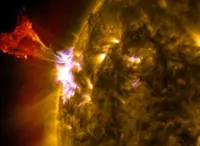This image provided by NASA shows a solar flare, as seen in the bright flash in the lower right, captured by NASA’s Solar Dynamics Observatory on May 9, 2024. A severe geomagnetic storm watch has been issued for Earth starting Friday and lasting all weekend, the first in nearly 20 years. Photo: NASA/SDO via AP
WASHINGTON: A huge solar storm begun pummeling Earth on Friday, bringing possible disruptions to satellites and power grids - and stunning auroras - as it intensifies.
The first of several coronal mass ejections (CMEs) -- expulsions of plasma and magnetic fields from the Sun -- arrived in the early afternoon, US eastern time, the National Oceanic and Atmospheric Administration (NOAA) said.




